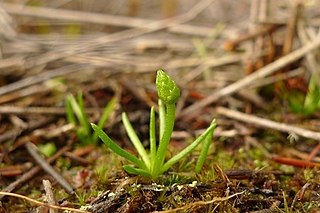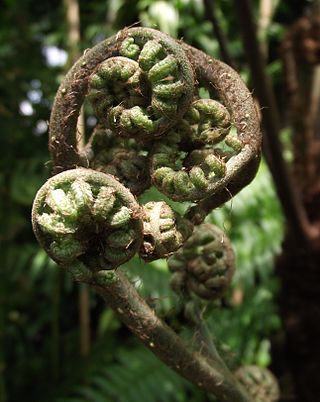
Isoetes, commonly known as the quillworts, is a genus of lycopod. It is the only living genus in the family Isoetaceae and order Isoetales. There are currently 192 recognized species, with a cosmopolitan distribution mostly in aquatic habitats but with the individual species often scarce to rare. Some botanists split the genus, separating two South American species into the genus Stylites, although molecular data place these species among other species of Isoetes, so that Stylites does not warrant taxonomic recognition. Species of Isoetes virtually identical to modern forms have existed since the Jurassic epoch.
Organic synthesis is a special branch of chemical synthesis and is concerned with the intentional construction of organic compounds. Organic molecules are often more complex than inorganic compounds, and their synthesis has developed into one of the most important branches of organic chemistry. There are several main areas of research within the general area of organic synthesis: total synthesis, semisynthesis, and methodology.

Phylloglossum, a genus in the clubmoss family Lycopodiaceae, is a small plant superficially resembling a tiny grass plant, growing with a rosette of slender leaves 2–5 cm long from an underground bulb-like root. It has a single central stem up to 5 cm tall bearing a spore-producing cone at the apex, and was previously classified variously in the family Lycopodiaceae or in its own family the Phylloglossaceae, but recent genetic evidence demonstrates it is most closely related to the genus Huperzia and is a sister clade to the genus Phlegmariurus, which was formerly included in Huperzia.

Edmund Clark Sanford (1859–1924) was an early American psychologist. He earned his PhD under the supervision of Granville Stanley Hall at Johns Hopkins University, and then moved with Hall to Clark University in 1888, where he became the professor of psychology and the founding director of the psychology laboratory. He is best known for his 1887 Writings of Laura Bridgman and for his 1897 textbook, A Course in Experimental Psychology. This textbook was a manual on how to conduct experiential psychology. He was present at the creation of the American Psychological Association in 1892 and the creation of the Association of American Universities in 1900. He was the cousin of another early psychologist, Milicent Shinn.

Lygodium microphyllum is a climbing fern originating in tropical Africa, Southeast Asia, Melanesia and Australia. It is an invasive weed in Florida where it invades open forest and wetland areas. The type specimen was collected in the vicinity of Nabúa, on the island of Luzon in the Philippines by Luis Née.
Dracoglossum is a small genus of ferns in the family Lomariopsidaceae, according to the Pteridophyte Phylogeny Group classification of 2016 (PPG I). It is native to the Neotropics of the Americas.

Bolbitis heteroclita is an aquatic fern species of Bolbitis, native to the Indochina region of tropical Southeast Asia.

Rolla Milton Tryon Jr. was an American botanist who specialized in the systematics and evolution of ferns and other spore-dispersed plants (pteridology). His particular focus and interest lay in two areas, historical biogeography of ferns and the taxonomy of tropical American ferns.

Macrothelypteris torresiana is a species of fern which is native to tropical and subtropical Africa and Asia. It has been introduced into other areas, including large parts of North and South America.
Cystodium is a fern in its own family, Cystodiaceae. It contains a single species: Cystodium sorbifolium(Sm.) J.Sm. 1841. Because it looks like a small tree fern, it had previously been placed in the tree fern family Dicksoniaceae. Subsequent analysis had moved it to the Lindsaeaceae, but the most recent phylogenetic studies have placed it in its own separate family, Cystodiaceae, with a sister relationship to the current Lindsaeaceae. A fossil species of the genus Cystodium sorbifolioides is known from the Cenomanian aged Burmese amber in Myanmar.
Ann Reed Mangels is a registered dietitian and Adjunct Associate Professor in the Department of Nutrition in the School of Public Health and Health Sciences at the University of Massachusetts Amherst, specializing in vegan and vegetarian nutrition. She is the author or co-author of numerous papers and books on the subject, including the American Dietetic Association's position paper on vegan and vegetarian diets, Vegan & Vegetarian FAQ (2001), The Dietitian's Guide to Vegetarian Diets (2004), and The Everything Vegan Pregnancy Book (2011).

Alice Faber Tryon (1920–2009) was an American botanist who specialized in the systematics of ferns and other spore-dispersed plants (pteridology). She had two general areas of interest in her work, first incorporating the use of spore surface patterns into the understanding of fern diversity and systematics, and second the fern family Pteridaceae.
Hypolepis parallelogramma is a species of fern native to the foothills of the Andes.

Quantum Computation and Quantum Information is a textbook about quantum information science written by Michael Nielsen and Isaac Chuang, regarded as a standard text on the subject. It is informally known as "Mike and Ike", after the candies of that name. The book assumes minimal prior experience with quantum mechanics and with computer science, aiming instead to be a self-contained introduction to the relevant features of both. The focus of the text is on theory, rather than the experimental implementations of quantum computers, which are discussed more briefly.
Florence Signaigo Wagner was an American botanist who served as president of the American Fern Society.
David Stoughton Conant was an American botanist, specializing in the systematics and genetics of tropical tree ferns.
Asplenium dielfalcatum is a species of fern in the family Aspleniaceae. It is native to Oahu, Hawaii.

Vittaria appalachiana, or the Appalachian shoestring fern, is a fern species in the subfamily Vittarioideae of the family Pteridaceae. It is native to moist and shaded outcrops in the Appalachian Mountains. It is notable for existing only in the gametophyte stage of development, unlike other fern species in which the sporophyte stage predominates. The species reproduces asexually through gemmae.

Alsophila firma, commonly known as the maquique fern, is a deciduous tree fern in the family Cyatheaceae endemic to Mexico, other countries of Central America, Colombia, and Ecuador. In the cloud forests of Mexico, it is considered an emblematic species and serves as a host for native epiphytic plants. However, habitat destruction and overconsumption of the trunks for handicraft production have threatened populations in Mexico. As a result, Alsophila firma is considered threatened in the state of Veracruz and has been given special protection per Mexican law.

Microgramma megalophylla is a species of epiphytic fern, native to tropical South America. It is a myrmecophyte, producing domatia in its rhizome which ants live.











